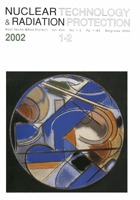
THE NATURE OF CHEMICAL BOND IN TRIOXIDE g-UO3

December 2002
UDC 621.039+614.876:504.06
YU ISSN 1451-3994
....Back to Contents
Pages: 3-12Authors: Yuri A. Teterin, Mikhail V. Ryzhkov, Anton Yu. Teterin, Alexander D. Panov, Anton S. Nikitin, Kirill E. Ivanov, Igor O. Utkin
Abstract
Low-energy X-ray photoelectron and conversion electron spectra from uranium trioxide were measured, and calculations were done for the [UO2O4]6-(D4h) cluster which reflects the structure of uranium close environment in g-UO3 in the non-relativistic and relativistic Xa-DVM approximation. This enabled a satisfactory qualitative and in some cases quantitative agreement between the experimental and theoretical data, and interpretation of such spectra. Despite the traditional opinion that before participation in the chemical binding, the U5f electrons could be promoted to the higher (for example - U6d) levels, it was theoretically proved and experimentally confirmed that the U5f electrons (about two U5f electrons) are able to participate directly in the chemical bond formation in uranium trioxide. The filled U5f states proved to be localized in the outer valence molecular orbitals energy range 4 eV - 9 eV, while the vacant U5f states were generally localized in the low-energy range (0 - 6 eV above zero). It was experimentally shown that U6p electrons not only participate effectively in the inner valence molecular orbital formation but also participate strongly (more than 1 U6p electron) in the formation of the filled outer valence molecular orbitals.
Key words: XPS, Xa-DVM, uranium oxide, uranyl group, outer valence (OVMO) and inner valence (IVMO) molecular orbitals
FULL PAPER IN PDF FORMAT (4.06 MB)
Last updated on September, 2010